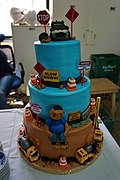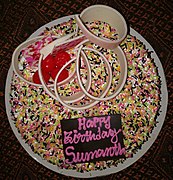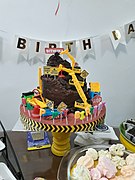| This article needs additional citations for verification. Please help improve this article by adding citations to reliable sources. Unsourced material may be challenged and removed. Find sources: "Birthday cake" – news · newspapers · books · scholar · JSTOR (June 2017) (Learn how and when to remove this message) |

A birthday cake is a cake eaten as part of a birthday celebration. While there is no standard for birthday cakes, they are typically highly decorated layer cakes covered in frosting, often featuring birthday wishes ("Happy birthdays") and the celebrant's name. In many cultures, it is also customary to serve the birthday cake with small lit candles on top, especially in the case of a child's birthday. The cake often accompanies the singing of "Happy Birthday to You". Variations include cupcakes, cake pops, pastries, and tarts.
History

Birthday cakes have been a part of birthday celebrations in Western European countries since the middle of the 19th century. However, the link between cakes and birthday celebrations may date back to ancient Roman times; in classical Roman culture, cakes were occasionally served at special birthdays and at weddings. These were circles made from flour and nuts, leavened with yeast, and sweetened with honey.
In Germany by the 18th century, the tradition of celebrating birthdays with a birthday cake and candles began. One of the most notable occasions where using a birthday cake with candles took form was during Count Ludwig von Zinzendorf of Marienborn's birthday party in 1746 in Germany. His cake was said to be as big as an oven could make it, with candles stuck in it, marking the years of his age. From the 18th century, elaborate cakes continued to take form, having many aspects of the contemporary birthday cake, like multiple layers, icing, and decorations. However, these cakes were only available to the very wealthy. Birthday cakes became accessible to the lower class as a result of the industrial revolution and the spread of more materials and goods.
Birthday candles and contemporary rites


The practice of serving cake on birthdays is commonplace in many cultures. In contemporary Western cultures, birthday cakes for children are often topped with candles, secured with special holders or simply pressed down into the outer frosting. In the Anglosphere, the number of candles often corresponds to the age of the individual being celebrated, occasionally with one extra for luck. An increasingly popular alternative is to use candles shaped as the numeral digits of the celebrant's age. Sparklers may also be used alongside or instead of the traditional wax candles.
The cake is usually presented with all the candles lit, at which point it is customary for the guests to sing Happy Birthday to You in unison, or an equivalent birthday song appropriate to the country. Upon the conclusion of the song, the celebrant is traditionally prompted to blow out the candles and make a wish, which is thought to come true if all the candles are extinguished in a single breath. Another common superstition holds that the wish must be made in silence, not to be shared with anyone else, or else it will not come true.
Theories of origin
See also: History of candle makingThough the exact origin of the birthday candle ritual is unknown, there are multiple theories which try to explain this tradition.
One theory explaining the tradition of placing candles on birthday cakes is attributed to the early Greeks, who used candles to honor the goddess Artemis' birth on the sixth day of every lunar month. The link between her oversight of fertility and the birthday tradition of candles on cakes, however, has not been established.

In 18th century Germany, the history of candles on cakes can be traced back to Kinderfest, a birthday celebration for children. This tradition also makes use of candles and cakes. German children were taken to an auditorium-like space. There, they were free to celebrate another year in a place where Germans believed that adults protected children from the evil spirits attempting to steal their souls. In those times there was no tradition of bringing gifts to a birthday; guests would merely bring good wishes for the birthday person. However, if a guest did bring gifts it was considered to be a good sign for the person whose birthday it was. Later, flowers became quite popular as a birthday gift.
- In 1746, a large birthday festival was held for Count Ludwig von Zinzendorf at Marienborn near Büdingen. Andrew Frey described the party in detail and mentions, "there was a Cake as large as any Oven could be found to bake it, and Holes made in the Cake according to the Years of the Person's Age, every one having a Candle stuck into it, and one in the Middle."
- Johann Wolfgang von Goethe, having spent 24–30 August 1801 in Gotha as a guest of Prince August of Saxe-Gotha-Altenburg, recounts of his 52nd birthday on 28 August: "when it was time for dessert, the prince's entire livery in full regalia entered, led by the majordomo. He carried a generous-size torte with colorful flaming candles – amounting to some fifty candles – that began to melt and threatened to burn down, instead of there being enough room for candles indicating upcoming years, as is the case with children's festivities of this kind." As the excerpt indicates, the tradition at the time was to place one candle on the cake for each year of the individual's life, so that the number of candles on top of the cake would represent the age which some one had reached; sometimes a birthday cake would have some added candles 'indicating upcoming years.'
A reference to the tradition of blowing out the candles was documented in Switzerland in 1881. Researchers for the Folk-Lore Journal recorded various "superstitions" among the Swiss middle class. One statement depicted a birthday cake as having lighted candles which correspond to each year of life. These candles were required to be blown out, individually, by the person who is being celebrated.
Bacteriology
In June 2017 researchers at Clemson University reported that some individuals deposit a large number of bacteria onto the cake frosting when blowing out the candles. They found that on average, the act increased the amount of bacteria by 14 times, but one of the researchers described this as "not a big health concern".
By culture
| This section needs additional citations for verification. Please help improve this article by adding citations to reliable sources in this section. Unsourced material may be challenged and removed. Find sources: "Birthday cake" – news · newspapers · books · scholar · JSTOR (March 2024) (Learn how and when to remove this message) |
There are many variations of sweets which are eaten around the world on birthdays. Different cultures have different unique birthday cake traditions.
Chinese
The Chinese birthday pastry is the shòu bāo (simplified Chinese: 寿包; traditional Chinese: 壽包) or shòu táo bāo (simplified Chinese: 寿桃包; traditional Chinese: 壽桃包), a lotus-paste-filled bun made of wheat flour and shaped and colored to resemble a peach. Rather than serving one large pastry, each guest is served their own small shòu bāo.
Russian and Lithuanian
In Western Russia, birthday children are served fruit pies with a birthday greeting carved into the crusts. As well in Russia and Lithuania, rather than a birthday cake, Russian adolescents receive a pie with a sweet birthday message that is illustrated with icing on top of the birthday pie.
Swedish
The Swedish birthday cake is made like a pound cake that is often topped with marzipan and decorated with the national flag. Dutch birthday pastries are fruit tarts topped with whipped cream.
English
Traditionally an English birthday cake is infused with artifacts that signify importance and good luck when baking the cake. To illustrate, adding a coin into the baking of the cake can represent financial success for the birthday individual. Different artifacts within cake can be used to symbolize a wish for the birthday girl or boy.
Egyptian
Birthday parties in Egypt consist of two different birthday cakes for the birthday girl or boy. Often only one birthday cake has a set of birthday candles while the other is left untouched. While two birthday cakes are significant in Egyptian culture, other sweet treats can be seen at birthday parties such as cakes known as “ghettos”.
Israeli
In Israel, individuals celebrate their birthdays with candles on their birthday cakes that align with the number of years the birthday individual was born. As well an additional candle is added to the birthday cake to represent a candle for the following year.
American
In the United States, lighting a birthday candle in correlation to the age of the birthday recipient is mirrored off of German customs. As well, singing happy birthday songs has become engraved in American birthday culture while the candles on the birthday are lit. In the 20th century a birthday trend became evident in American culture where a birthday want or desire would only be achieved if the birthday recipient blew the candle in one exhale.
Gallery
-
 2nd birthday cake
2nd birthday cake
-
 Christmas tree birthday cake
Christmas tree birthday cake
-
 Birthday cake with a written message
Birthday cake with a written message
-
 Construction worker themed birthday cake
Construction worker themed birthday cake
-
 100th birthday cake with 100 candles
100th birthday cake with 100 candles
-
 Birthday cake in the shape of a Lace monitor
Birthday cake in the shape of a Lace monitor
-
 Elaborately layered birthday cake
Elaborately layered birthday cake
-
 Birthday cake garnished with a birthday party diorama
Birthday cake garnished with a birthday party diorama
-
 18th birthday cake
18th birthday cake
-
 Chocolate with assorted fruit birthday cake
Chocolate with assorted fruit birthday cake
-
 Tteok-cake
Tteok-cake
-
Creamy raspberry birthday cake
-
 Association football themed birthday cake
Association football themed birthday cake
-
 Homemade birthday cake
Homemade birthday cake
-
 Birthday cake with a "3" shaped candle
Birthday cake with a "3" shaped candle
-
 German cake for a 100th birthday
German cake for a 100th birthday
-
 Birthday cake in the shape of a ladybug
Birthday cake in the shape of a ladybug
-
 Mixed fruit birthday cake
Mixed fruit birthday cake
-
 Construction worker themed birthday cake
Construction worker themed birthday cake
-
 25th birthday mint mousse cake
25th birthday mint mousse cake
-
 Birthday cake with lit candles
Birthday cake with lit candles
-
 Multicolored Birthday Cake (Bloomsburg, Pennsylvania)
Multicolored Birthday Cake (Bloomsburg, Pennsylvania)
See also
References
- "Birthday Cakes: History & Recipes – Online article with an extensive bibliography".
- Humble, Nicola (2010-05-15). Cake: A Global History. Reaktion Books. ISBN 978-1-86189-730-5.
- ^ Gage, Mary (2012). "Birthday Cakes: History & Recipes" (PDF). New England Recipes: 1.
- Marcus, Ivan G. (1 March 2012). The Jewish Life Cycle: Rites of Passage from Biblical to Modern Times. University of Washington Press. p. 120. ISBN 978-0-295-80392-0.
- ^
Sarah Zhang (2017-07-27). "Blowing Out Birthday Candles Increases Cake Bacteria by 1,400 Percent: But it's okay, really!". Atlantic magazine. Retrieved 2017-12-03.
On average, blowing out the candles increased the amount of bacteria on the frosting by 14 times. But in one case, it increased the amount of bacteria by more than 120 times. "Some people blow on the cake and they don't transfer any bacteria. Whereas you have one or two people who really for whatever reason ... transfer a lot of bacteria." says Dawson."
- ^
Sarah Young (2017-07-31). "Blowing out birthday candles increases bacteria on cake by 1,400%, study reveals". The Independent. Retrieved 2017-12-03.
They then lit the candles and blew them out before diluting the frosting with sterilised water and spreading it out on agar plates for the bacteria to grow.
- ^ Elizabeth Sherman (2017-07-28). "Blowing Out Birthday Candles Could Ruin the Cake". Food & Wine. Retrieved 2017-12-03.
- Rusinek, Marietta (2012). "Cake:The Centrepiece of Celebrations". Celebration: Proceedings of the Oxford Symposium on Food and Cookery 2011. Oxford: Prospect Books. pp. 308–315.
- "Keeping the Legacy". German Hausbarn. Archived from the original on 2016-10-05. Retrieved 2015-08-12.
- "History of Birthdays". Archived from the original on 2020-01-30. Retrieved 2013-11-04.
- Frey, Andreas (1753-01-01). A true and authentic account of Andrew Frey. Containing the occasion of his coming among the ... Moravians [&c.]. Transl.
- Shirley Cherkasky: Birthday Cakes and Candles, p. 220 books.google. Goethe's Tag- und Jahreshefte 1801 http://www.zeno.org/nid/20004859979
- The Folk-lore Journal. Folk-lore Society. 1883-01-01. p. 380.
-
Paul Dawson, Inyee Han, Danielle Lynn, Jenevieve Lackey, Johnson Baker, Rose Martinez-Dawson (2017). "Bacterial Transfer Associated with Blowing Out Candles on a Birthday Cake". Journal of Food Research. Vol. 6, no. 4. Retrieved 2017-12-03.
{{cite news}}: CS1 maint: multiple names: authors list (link) - Redlich, Orly (2020). "The Concept of Birthday: A Theoretical, Historical, and Social Overview, in Judaism and Other Cultures". World Academy of Science, Engineering and Technology International Journal of Humanities and Social Sciences. 14 (14): 791–800 – via International Scholarly and Scientific Research & Innovation.
- Redlich, Orly (2020). "The Concept of Birthday: A Theoretical, Historical, and Social Overview, in Judaism and Other Cultures". World Academy of Science, Engineering and Technology International Journal of Humanities and Social Sciences. 14: 791–800 – via International Scholarly and Scientific Research & Innovation.
- Redlich, Orly (2020). "The Concept of Birthday: A Theoretical, Historical, and Social Overview, in Judaism and Other Cultures". World Academy of Science, Engineering and Technology International Journal of Humanities and Social Sciences. 14: 791–800 – via International Scholarly and Scientific Research & Innovation 14(9) 2020.
- Redlich, Orly (2020). "The Concept of Birthday: A Theoretical, Historical, and Social Overview, in Judaism and Other Cultures". World Academy of Science, Engineering and Technology International Journal of Humanities and Social Sciences. 14: 791–800.
- ^ Gage, Mary and James (2012). "Birthday Cakes: History & Recipes" (PDF). New England Recipes: 1–16.